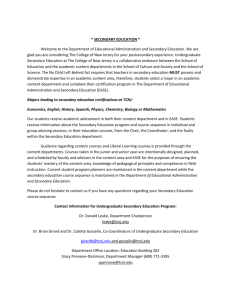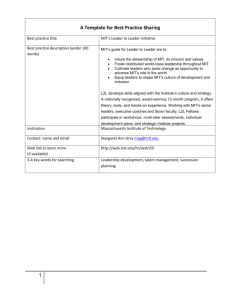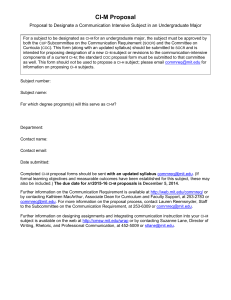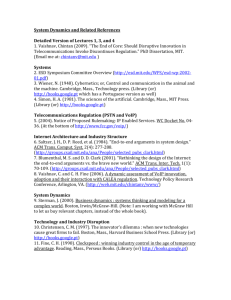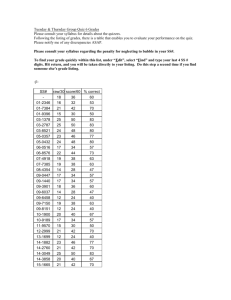MIT 201, Information Systems: Concepts and
advertisement
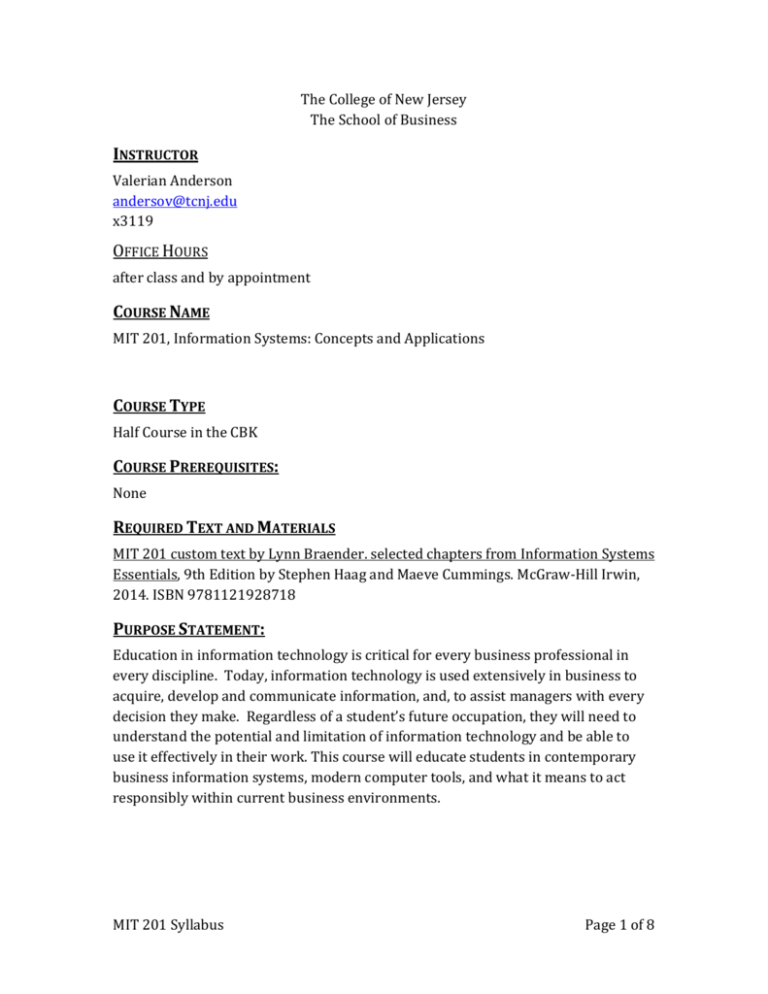
The College of New Jersey The School of Business INSTRUCTOR Valerian Anderson andersov@tcnj.edu x3119 OFFICE HOURS after class and by appointment COURSE NAME MIT 201, Information Systems: Concepts and Applications COURSE TYPE Half Course in the CBK COURSE PREREQUISITES: None REQUIRED TEXT AND MATERIALS MIT 201 custom text by Lynn Braender. selected chapters from Information Systems Essentials, 9th Edition by Stephen Haag and Maeve Cummings. McGraw-Hill Irwin, 2014. ISBN 9781121928718 PURPOSE STATEMENT: Education in information technology is critical for every business professional in every discipline. Today, information technology is used extensively in business to acquire, develop and communicate information, and, to assist managers with every decision they make. Regardless of a student’s future occupation, they will need to understand the potential and limitation of information technology and be able to use it effectively in their work. This course will educate students in contemporary business information systems, modern computer tools, and what it means to act responsibly within current business environments. MIT 201 Syllabus Page 1 of 8 COURSE DESCRIPTION: MIT 201 provides students with a fundamental understanding of information technology in contemporary business environments. In this half course, students will study essential information systems found in current and emerging business models. Discussion will focus on information technology, contemporary decision support tools, and standards of behavior required of professionals working with information and information technology. This class uses a combination of lecture (50%) and lab experiences (50%) to explore current trends in information technology. Students will learn about technology and its impact on the business through readings from books, RSS feeds and other published resources including podcasts, discussions, and independent exploration. Students will work in a team and individual environment to solve business problems using decision support systems with MS Excel. LEARNING OUTCOMES: Upon completion of MIT 201, students will be able to: 1) Identify and differentiate core business information systems that exist in current and emerging business models. 2) Describe the responsibility needed by modern workers to protect and secure an organization’s information. 3) Use the data management and manipulation tools found in decision support systems to solve business problems. ESSENTIAL QUESTIONS: Students should be able to answer the following questions by the end of the course. 1) What are the principal business applications used by contemporary organizations? 2) What is the difference between operational and a strategic information systems? 3) What is a decision support system and how does it differ from other types of information systems? 4) How do organizations manage data and what are some of the issues they face with this task? 5) What measures should modern workers adopt to protect and secure organizational information? 6) What guidelines should modern workers follow to minimize unethical or illegal computing behavior? MIT 201 Syllabus Page 2 of 8 LEARNING ACTIVITIES MIT 201 course meetings will be divided equally between lecture and laboratory sessions. During the lectures, students will have opportunities to participate in discussions, to complete in-class break out projects, and to review concise and focused homework assignments. Lectures will be supplemented with current published items, news items and podcasts from National Public Radio. These published items will highlight current technology issues facing businesses, government, society, and the individual. Theory will be balanced with application in the lab. Students will learn to apply concepts by working with organizational information technology including the college’s information system and the Internet. Students will learn how to protect, manage, and secure technological resources, to work in virtual collaborative environments, and to manipulate and analyze data files through case-based learning. STUDENT ASSESSMENT: Student assessment will include (1) objective quizzes to tests students’ understanding of the concepts presented in this course; (2) Excel cases to solve business problems; and (3) an applications test in Excel. The excel cases will be completed in a group environment whereas the applications test will be completed by each student. Students will be required to complete non-graded homework assignments to assure readiness for the group cases and the final exam. The final applications exam in Excel will be cumulative in nature and based upon the graded and non-graded work completed during the course. GRADE ALLOCATION: Midterm…………………………. 25% Final Application Test……………… 35% Homework & Cases………………... 40% Participation………………………... May be used to alter borderline grades; grades may increase or decrease depending upon the student's demonstration of knowledge during class. MIT 201 Syllabus Page 3 of 8 PERFORMANCE SCALE: Final Grade Average Points A 94 - 100 A- 90 – 93.9 B+ 87 – 89.9 B 84 – 86.9 B- 80 – 83.9 C+ 77 – 79.9 C 74 – 76.9 C- 70 – 73.9 D+ 66 – 69.9 D 60 – 65.9 Criteria for Grades on Cases, Application Test and Quizzes: 1. The cases and final applications test focus on organizing and analyzing data from business cases and performing data analysis using Excel and other relevant business tools. Cases will be graded on the student’s ability to satisfy stated case requirements and to synthesize and integrate course concepts when presenting findings to support decisions. Case requirements will include completeness (all questions posed to the student are answered), explanations for results, correct results, and presentation of results. The assignment of plus (+) and minuses (-) to grades will occur based upon the judgment of the teacher and the student’s ability to demonstrate varying levels of understanding. The table in the next section illustrates general grading guidelines. MIT 201 Syllabus Page 4 of 8 2. Students will complete some exercises in Excel that will be self-graded. Students will be assigned homework and will compare their work with the teacher’s completed work. By doing so, individual students are able to compare their understanding and skill level with course expectations. 3. Students will be expected to use the college’s information system and current information systems tools to complete homework in a virtual environment. Students will be required to effectively use the college’s information system, and to learn how to manage, secure, and protect their information resources and to work in virtual environments. Students will be required to manage their course files in their assigned network space, to create and manage a shared virtual environment with their group members, and to protect their team work from viruses, loss, and online attacks. Homework will be reviewed in class to determine students’ understanding of concepts. Students will be tested on these homework concepts in the quizzes and final exam. 4. Discussions with individual students may be used to evaluate the student's ability to analyze informational needs and satisfy those needs through the design of business reports. Students will need to explore Excel tools, best practices, and contemporary methods for employing technology. The results of discussions with individual students will be the basis for assessing the student's ability to seek relevant information and apply that information to satisfying information needs and to alter border-line grades. ATTENDANCE The course blends both theory and application into the learning environment. To accomplish this, we spend approximately 50% of our time working with theory and the other 50% working on tasks with a team of students. To complete these tasks, we will spend approximately 50% of our time in the lab. To learn, you must actively participate in both the classroom and the lab. You are required to attend classes and all labs. If you have to miss a class or team meeting, you need to call my office and leave a message with the reasons for you absence; you also need to notify your group if you are working on a team assignment. In addition, you should not schedule interviews, work, vacations, appointments, or any other non-course related event during scheduled classes. During test time, if you believe that you are entitled to an excused absence for medical reasons or family emergencies you are expected to contact me before the class session, or within a reasonable time frame, for which you will be absent. Justifications for absences after-the-fact may require corroboratory documentation. Save extraordinary MIT 201 Syllabus Page 5 of 8 situations, no "make-up" exams will be given. Depending on the circumstances surrounding your failure to have taken an exam as scheduled, either you will receive a failing grade on the missed exam or, in the event of a bona-fide excuse; the other graded criteria for the course will be adjusted on a pro-rata basis to calculate your final grade. If you have a special, diagnosed learning need, you should arrange to meet with me at the earliest possible, mutually convenient, time. If you are an athlete with a travel schedule, which may interfere with your ability to meet the requirements described in this syllabus, you must meet with me after the first class session. Dean's Attendance Policy: Except in the case of a TCNJ authorized absence or documented personal emergency, faculty are encouraged NOT to make individual exceptions to course assignment due dates and exams. Our work is no less coordinated or time-sensitive than many tasks encountered in the workplace and meeting deadlines and obligations is simply one more step in preparation for a business career. TCNJ’s Attendance Policy: http://www.tcnj.edu/~recreg/policies/attendance.html ACADEMIC INTEGRITY Students are required to adhere to the academic integrity policy set forth by the college. Violations of this college policy may be sent to the School of Business' Academic Integrity Officer. In addition to academic performance, you are expected to demonstrate the qualities of honesty and integrity. All submissions by you or your team are expected to be your original work. Material that, in any way, volatiles this principle, or any form of dishonesty, cheating, fabrication, the facilitation of academic dishonesty, and/or plagiarism, may result in the your receiving a failing grade for the assignment, quiz, test, or the course. In addition, further appropriate disciplinary action may be initiated. TCNJ’s academic integrity policy is available on the web: http://www.tcnj.edu/~academic/policy/integrity.html. WRITING POLICY Because writing is a fundamental business skill, your grade for each assignment will reflect, among other things, your ability to write; even for assignments with minimum writing. Feedback on your writing will be provided as deemed necessary and, if your writing needs improvement, you should seek help from the Writing Center at (http://www.tcnj.edu/~tutoring/humanities/writing.html), from someone who writes well, or some other writing source. The responsibility to write well is yours. My responsibility is to hold you MIT 201 Syllabus Page 6 of 8 accountable for how well you write. Poor writing will be reflected in your final grade. CLASSROOM BEHAVIORS To enhance the learning environment and to keep with the values held by the college, we are all responsible for contributing to a respectful environment. To accomplish this, we all need to adhere to the following behaviors: 1. Refrain from using disruptive technology during the class or labs. Disruptive technology includes, but is not limited to, cell phones, email, Internet surfing, IM, and games. If you are expected an important call, you need to alert me before class begins, put your phone on the vibrator, and take the call away from any classroom. 2. Do not speak when someone else is speaking. 3. Do not work on projects that fall outside of this course. 4. Treat each person in the class with respect, consideration, and kindness. OTHER IMPORTANT INFORMATION AMERICANS WITH DISABILITIES ACT (ADA) POLICY Any student who has a documented disability and is in need of academic accommodations should notify me on the first day of this course and contact the Office of Differing Abilities Services (609-771-2571). Anyone requiring special adaptations or accommodations will benefit from contacting Terri Yamiolkowski in the Office of Differing Abilities (771.2571). Accommodations are individualized and in accordance with Section 504 of the Rehabilitation Act of 1973 and the Americans with Disabilities Act of 1992. TCNJ’S AMERICANS WITH DISABILITIES ACT (ADA) POLICY IS AVAILABLE ON THE WEB: http://policies.tcnj.edu/policies/viewPolicy.php?docId=8082 ACADEMIC ENHANCEMENT CENTER: The Academic Enhancement Center, which is located in Forcina Hall 145, is an excellent place to get help on your papers. Call The Write Place at 771-2895 or 771-3325, or see the hours available at http://www.tcnj.edu/~assistn/lhw.htm. MIT 201 Syllabus Page 7 of 8 Topics Excel Skills Insert and Delete Cells, Blocks, and Worksheets Formatting Cells, Blocks, Worksheets; Numerical Formats, Date Formats, Text Formats; Alignment, Indentation; Cell and Block colors, shading, sizing, borders; Adjusting column and row size; Remedial Skills Setting print areas, customized footers (e.g., automatic dates, automatic page numbers, automatic folder, file, and tab names), customized headers, repeated column and rows, adjusting margins and print orientation, print scales, automatic grids, print quality; printing and documenting formulas. Creating simple formulas (e.g., column and row sums, order of precedence, cell references, persistent data) Presentation Conditional formatting, automatic formatting, table styles, customizing style Use of white space, text boxes, shapes, transparent objects Pivot Tables Data Validation Graphs Data Analysis Importing and Exporting Data Goal Seeking Filters Automatic Subtotals Database Functions (Running Statistics on Groups) Inserting Page Breaks Protecting Cells, Blocks, and Worksheets Misc. Hiding and Unhiding Data Freezing and Unfreezing headings Adding and reviewing comments Merging Cells MIT 201 Syllabus Page 8 of 8

